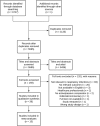Interventions to increase personal protective behaviours to limit the spread of respiratory viruses: A rapid evidence review and meta-analysis
- PMID: 34173697
- PMCID: PMC12086758
- DOI: 10.1111/bjhp.12542
Interventions to increase personal protective behaviours to limit the spread of respiratory viruses: A rapid evidence review and meta-analysis
Abstract
Purpose: Increasing personal protective behaviours is critical for stopping the spread of respiratory viruses, including SARS-CoV-2: We need evidence to inform how to achieve this. We aimed to synthesize evidence on interventions to increase six personal protective behaviours (e.g., hand hygiene, face mask use, maintaining physical distancing) to limit the spread of respiratory viruses.
Methods: We used best practice for rapid evidence reviews. We searched Ovid MEDLINE and Scopus. Studies conducted in adults or children with active or passive comparators were included. We extracted data on study design, intervention content, mode of delivery, population, setting, mechanism(s) of action, acceptability, practicability, effectiveness, affordability, spill-over effects, and equity impact. Study quality was assessed with Cochrane's risk-of-bias tool. A narrative synthesis and random-effects meta-analyses were conducted.
Results: We identified 39 studies conducted across 15 countries. Interventions targeted hand hygiene (n = 30) and/or face mask use (n = 12) and used two- or three-arm study designs with passive comparators. Interventions were typically delivered face-to-face and included a median of three behaviour change techniques. The quality of included studies was low. Interventions to increase hand hygiene (k = 6) had a medium, positive effect (d = .62, 95% CI = 0.43-0.80, p < .001, I2 = 81.2%). Interventions targeting face mask use (k = 4) had mixed results, with an imprecise pooled estimate (OR = 4.14, 95% CI = 1.24-13.79, p < .001, I2 = 89.67%). Between-study heterogeneity was high.
Conclusions: We found low-quality evidence for positive effects of interventions targeting hand hygiene, with unclear results for interventions targeting face mask use. There was a lack of evidence for most behaviours of interest within this review.
Keywords: COVID-19; SARS-CoV-2; behaviour change; intervention; personal protective behaviours; rapid review.
© 2021 The Authors. British Journal of Health Psychology published by John Wiley & Sons Ltd on behalf of British Psychological Society.
Conflict of interest statement
All authors declare no conflict of interest.
Figures






Similar articles
-
Physical interventions to interrupt or reduce the spread of respiratory viruses.Cochrane Database Syst Rev. 2020 Nov 20;11(11):CD006207. doi: 10.1002/14651858.CD006207.pub5. Cochrane Database Syst Rev. 2020. Update in: Cochrane Database Syst Rev. 2023 Jan 30;1:CD006207. doi: 10.1002/14651858.CD006207.pub6. PMID: 33215698 Free PMC article. Updated.
-
What did we learn about changing behaviour during the COVID-19 pandemic? A systematic review of interventions to change hand hygiene and mask use behaviour.Int J Hyg Environ Health. 2024 Apr;257:114309. doi: 10.1016/j.ijheh.2023.114309. Epub 2024 Feb 6. Int J Hyg Environ Health. 2024. PMID: 38325104
-
Folic acid supplementation and malaria susceptibility and severity among people taking antifolate antimalarial drugs in endemic areas.Cochrane Database Syst Rev. 2022 Feb 1;2(2022):CD014217. doi: 10.1002/14651858.CD014217. Cochrane Database Syst Rev. 2022. PMID: 36321557 Free PMC article.
-
Physical distancing, face masks, and eye protection to prevent person-to-person transmission of SARS-CoV-2 and COVID-19: a systematic review and meta-analysis.Lancet. 2020 Jun 27;395(10242):1973-1987. doi: 10.1016/S0140-6736(20)31142-9. Epub 2020 Jun 1. Lancet. 2020. PMID: 32497510 Free PMC article.
-
Community interventions in Low-And Middle-Income Countries to inform COVID-19 control implementation decisions in Kenya: A rapid systematic review.PLoS One. 2020 Dec 8;15(12):e0242403. doi: 10.1371/journal.pone.0242403. eCollection 2020. PLoS One. 2020. PMID: 33290402 Free PMC article.
Cited by
-
Communication to promote and support physical distancing for COVID-19 prevention and control.Cochrane Database Syst Rev. 2023 Oct 9;10(10):CD015144. doi: 10.1002/14651858.CD015144. Cochrane Database Syst Rev. 2023. PMID: 37811673 Free PMC article. Review.
-
Thinking of future as an older individual increases perceived risks for age-related diseases but not for COVID-19.Int J Psychol. 2022 Feb;57(1):96-106. doi: 10.1002/ijop.12789. Epub 2021 Jun 24. Int J Psychol. 2022. PMID: 34169518 Free PMC article. Clinical Trial.
-
Descriptive, injunctive, or the synergy of both? Experimenting normative information on behavioral changes under the COVID-19 pandemic.Front Psychol. 2022 Dec 22;13:1015742. doi: 10.3389/fpsyg.2022.1015742. eCollection 2022. Front Psychol. 2022. PMID: 36643703 Free PMC article.
-
Children wearing face masks to prevent communicable diseases: scoping review.Rev Paul Pediatr. 2022 Jul 15;41:e2021164. doi: 10.1590/1984-0462/2023/41/2021164. eCollection 2022. Rev Paul Pediatr. 2022. PMID: 35858041 Free PMC article.
-
Nurses' Perceptions of the Quality of Perinatal Care Provided to Lesbian Women.Front Psychol. 2022 Feb 22;13:742487. doi: 10.3389/fpsyg.2022.742487. eCollection 2022. Front Psychol. 2022. PMID: 35273537 Free PMC article.
References
-
- Aiello, A. E. , Murray, G. F. , Perez, V. , Coulborn, R. M. , Davis, B. M. , Uddin, M. , … Monto, A. S. (2010). Mask use, hand hygiene, and seasonal influenza‐like illness among young adults: A randomized intervention trial. The Journal of Infectious Diseases, 201(4), 491–498. 10.1086/650396 - DOI - PubMed
-
- Arbogast, J. W. , Moore‐Schiltz, L. , Jarvis, W. R. , Harpster‐Hagen, A. , Hughes, J. , & Parker, A. (2016). Impact of a comprehensive workplace hand hygiene program on employer health care insurance claims and costs, absenteeism, and employee perceptions and practices. Journal of Occupational and Environmental Medicine, 58, e231–e240. 10.1097/JOM.0000000000000738 - DOI - PMC - PubMed
Publication types
MeSH terms
Grants and funding
LinkOut - more resources
Full Text Sources
Medical
Miscellaneous

